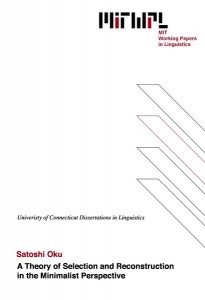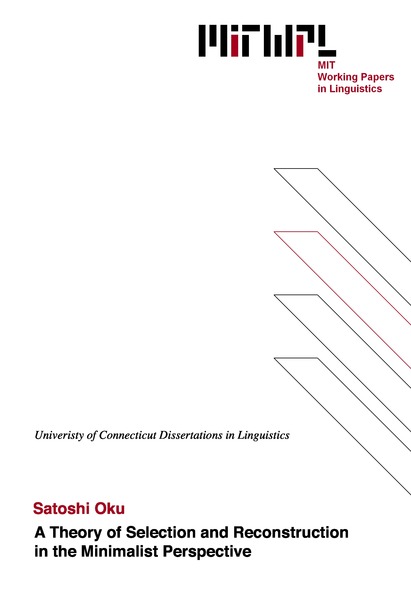A Theory of Selection and Reconstruction in the Minimalist Perspective
S. Oku, 1998
ABSTRACT
This study extends two ideas of the minimalist program in linguistic theory (Chomsky 1992, 1994, 1995a) (LF feature decomposition and elimination of D-structure), and explores various consequences of this extension. First, Chomsky (1995a) proposes the Move F(eature) hypothesis which implies that feature decomposition of a lexical item (or a syntactic object consisting of lexical items) is possible in covert syntax (LF). Assuming that LF Copy is a syntactic operation to construct a phonologically missing element in ellipsis structures, I propose the subset copy principle to the effect that a (proper) subset of the antecedent features can construct the contents of a phonologically missing element under LF Copy; the feature composition of a copy can be less than the feature composition of the original. I argue that the subset copy principle plays a significant role in LF construction and interpretation of both verbal morphology (Chapter 2) and nominal expressions (Chapter 4) in the elliptic site. A certain asymmetry in verbal morphology construction in VP-ellipsis receives a natural account under the subset copy principle, and a new theory of interpretation of nominal expressions in VP-ellipsis is developed, which gives an account of possible interpretation of VP-ellipsis when a full copy of the original cannot provide an appropriate LF representation. The second part of this work discusses the nature of Selection in the minimalist program. Selection has been stated as a D-structure property (e.g., Chomsky 1965, 1981) but it cannot be stated in such a way in the minimalist framework, since one of the characteristics of the minimalist program is its attempt to eliminate D-structure (and S-structure). Extending Boskovic and Takahashi's (1998) theory of LF Lowering movement into a $\theta$-position, I propose that selectional properties of a head are syntactic features to be checked during the derivation, and that some selectional features are weak in the sense that they can be checked in covert syntax. Some properties of Japanese null arguments receive an account based on exactly the same theory of Japanese predicates as the one proposed in Boskovic and Takahashi. Consequences of the selection theory on English VP-ellipsis/VP-fronting are also explored.
TABLE OF CONTENTS
Chapter 1: Introduction
1.1 Goals 1
1.2 LF Feature Decomposition 1
1.3 Radial Acyclic Mage in Covert Syntax 1
1.4 General Picture of the System 9
Notes to Chapter 1 15
Chapter 2: LF Construction of Ellipsis and the Subset Copy Principle: Verbal Morphology 16
2.1 Verbal Morphology and the Subset Copy Principle 17
2.2 An Apparent Counter Example: Perfective Participle 21
2.3 A Potential Alternative: PF Deletion and an Affix Hopping Approach 30
2.4 Participle Morphology and Semantic Interpretation 34
2.5 Aux Have/Be and the Nature of Head Movement 36
2.6 Some Problematic Cases 47
2.7 Summary of Chapter 2 53
Notes to Chapter 2 55
Chapter 3: Rooth/Tomioka Approach to Pronominal Interpretation 60
3.1 Rooth (1992a, 1992b): Alternative Semantics for Focus 62
3.2 Pronominal Interpretation under Alternative Semantics for Focus 65
Notes to Chapter 3 72
Chapter 4: LF Construction of Ellipsis and the Subset Copy Principle: Identity and Nominal Interpretation 73
4.1 Introduction 73
4.2 The Predicate Abstraction Approach: Sag (1976) and Williams (1977) 77
4.3 The Predicate Abstraction Analysis vs. Kitagawa's (1991) Analysis 89
4.3.1 A Contrast between Reflexive Pronouns and Pronouns 89
4.3.2 Identity Preservation and Coping of Indices 92
4.4 Fiengo and May (1994) 94
4.5 Cases of Non-identity: a Minimalist Approach 98
4.5.1 Feature Mismatch and "Vehicle Change" 99
4.5.2 Reflexive to Pronoun 112
4.5.3 Two Types of Strict Identity 126
4.5.4 Locality Effect on the Sloppy Identity Interpretation Revisited 130
4.5.5 Defective Pronouns and E-type Anaphors 139
4.6 Summary of Chapter 4 145
Notes to Chapter 4 I46
Chapter 5: Scrambling, Null Arguments, and a Theory of Covert Selection 152
5.1 Introduction 152
5.2 Bošković and Takahashi (1998): An LF Analysis of Scrambling 153
5.3 Sloppy Identity Interpretation and the Nature of Japanese Null
Arguments 161
5.3.1 Overview 161
5.3.2 Against the VP-ellipsis Analysis 164
5.3.3 Deriving Null Argument Properties: LF Copy Analysis l74
5.4 VP-Ellipsis and VP-Preposing 190
5.5 Radical Acyclic Merger and a Theory of Phrase Structure Building 202
5.6 Summary of Chapter 5 213
Notes no Chapter 5 215
Bibliography 221

